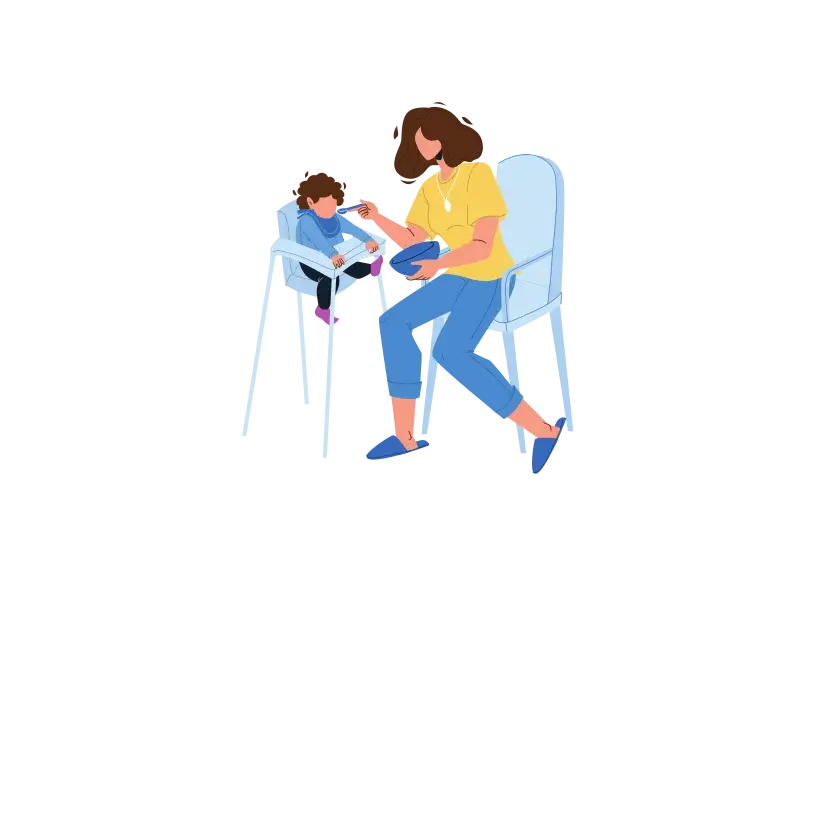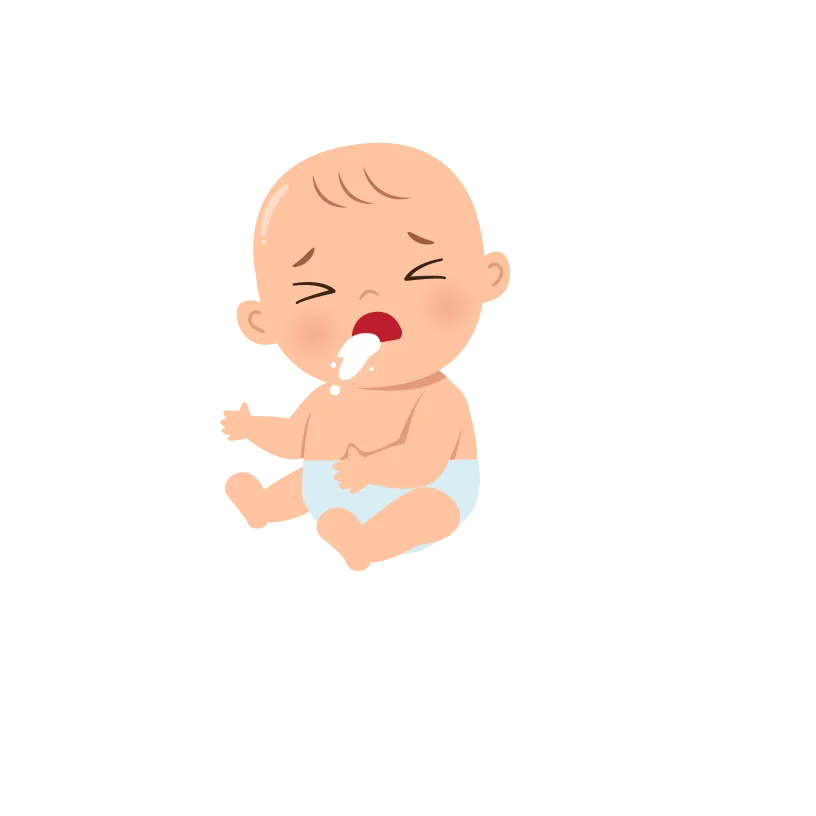Menu

Imagine you’ve been feeding your baby either formula or breastmilk for months, and now it’s time to start introducing them to solid foods. It’s a big deal because it’s a new world of tastes and textures for your little one to explore.
But it’s okay if you’re feeling a bit unsure about how to do it safely. Just like when you first started feeding your baby milk, starting solids can be tricky, especially when considering food allergies and what foods to start with.
Think of it as a new adventure you’re embarking on with your baby. It’s exciting but also nerve-wracking, especially if you’re a first-time parent.
Your paediatrician will likely give you the green light to start introducing solid foods, also known as baby food, when your baby shows signs of readiness, typically between 4 and 6 months. Until then, breast milk or formula is all your baby needs for nourishment.
This timing is important because babies don’t have the physical ability to swallow solid foods before four months safely, and their digestive systems aren’t mature enough to handle them. So, sticking to breast milk or formula ensures your baby gets all the necessary calories and nutrients to support their growth and development during those early months.
The American Academy of Pediatrics (AAP) and the World Health Organization (WHO) recommend exclusive breastfeeding for the first six months of your baby’s life, with the introduction of solids starting at around six months old. The AAP suggests continuing breastfeeding until your baby is at least one year old and longer if desired by both you and your baby.
When introducing solid foods, focus on iron-rich options and ensure the texture suits your baby. Watch for signs that your baby is ready to start solids.
As for timing, there’s no set recommendation for the best time of day to introduce solids. However, offering them after a milk feed mid-morning can be beneficial, as it’s less likely to disrupt nighttime sleep if your baby becomes unsettled.
If you notice your baby is eating solid foods eagerly and cutting back on breastfeeds or bottle feeds, offer smaller portions of solids. Remember, breast milk or formula remains crucial for nutrition during the first 9 to 12 months of life.
Sit your baby on your lap and begin offering food gradually. While some parenting experts suggest using an infant seat for feeding, ensure it can be adjusted to an upright position for safety. Avoid seats that recline too much, as they may not provide adequate support during feeding.
Use a small, soft spoon instead of metal to avoid hurting your baby’s gums. If they don’t like the spoon, use your clean finger to let them suck or gum the food off. This helps them learn how to eat from utensils and encourages proper feeding habits from the start.
If your baby doesn’t seem to like a particular food in one form, such as pureed, try offering it in a different form, such as mashed or finger food. This allows your baby to explore different textures and may increase their food acceptance.
To monitor for potential allergies or adverse reactions, it’s recommended to introduce one new food at a time and offer it consistently for three days before introducing another. This helps you identify any foods that may not agree with your baby.
Remember, taste is a sense; for infants, it’s not as developed as their other senses.
It’s like experiencing bright lights or loud noises for the first time. So, even if your baby enjoys the food you give them, trying a new taste might be a surprising experience for them at first.

Your baby should be able to sit upright with or without assistance. This helps ensure they can swallow food safely and reduces the risk of choking.

Your baby should have good control over their head and neck movements. This is important for safe eating and prevents them from accidentally choking on food.

When you offer food to your baby, they should instinctively open their mouth in anticipation of eating. This shows that they are ready and willing to try solid foods.

When your baby eats, they should be able to move food from the front of their mouth to the back of their tongue to swallow it effectively. This ensures they can safely consume solid foods without choking.

Your baby should show an interest in bringing objects, including food, to their mouth. This demonstrates their readiness to explore and taste different textures.

Your baby should be able to grasp small objects, like toys or pieces of food, using their fingers. This helps them pick up and manipulate food when self-feeding.

Your baby should be able to sit upright with or without assistance. This helps ensure they can swallow food safely and reduces the risk of choking.

Your baby should have good control over their head and neck movements. This is important for safe eating and prevents them from accidentally choking on food.

When you offer food to your baby, they should instinctively open their mouth in anticipation of eating. This shows that they are ready and willing to try solid foods.

When your baby eats, they should be able to move food from the front of their mouth to the back of their tongue to swallow it effectively. This ensures they can safely consume solid foods without choking.

Your baby should show an interest in bringing objects, including food, to their mouth. This demonstrates their readiness to explore and taste different textures.

Your baby should be able to grasp small objects, like toys or pieces of food, using their fingers. This helps them pick up and manipulate food when self-feeding.
When introducing solids through purees, aim for a super smooth texture that practically drips off the spoon. If you’re making your baby food, ensure it’s strained, pureed, or finely mashed, and consider thinning it with liquid if needed. For the first foods, consider starting with:
To add variety to your baby’s diet, around 7 to 8 months, you can introduce minced meat, mashed eggs, whole milk yoghurt, cheese, pasta, beans, and tofu.
Avoid honey until your baby is at least one year old due to the risk of infantile botulism. While cow’s milk should also be delayed until age 1, whole milk yoghurt, cottage cheese, and hard cheese are generally safe options by about eight months. Ensure your baby gets plenty of iron-rich foods crucial for their development.
Some parents opt for baby-led weaning, offering their baby finger foods exclusively and allowing them to self-feed rather than spoon-feeding puréed or mashed foods. This allows younger babies to explore the textures and flavours by gnawing on the food, even if they don’t have teeth yet.
If you’re considering baby-led weaning, it’s typically recommended to wait until around 6 months old. By this age, your baby should be able to pick up food, bring it to their mouth, chew and swallow. Remember that it might take a few more months before your baby masters the pincer grasp needed for smaller finger foods, usually around eight months old.
You can start incorporating the following finger foods for added exploration and enjoyment.
As concerning as it may appear, you need to understand the difference between choking and gagging when introducing solid foods to your baby.
Gagging is a normal reflex as babies learn to chew and swallow solid foods. It’s usually loud, and you may notice your baby’s skin turning red during gagging, although this may be harder to see on darker skin tones.
On the other hand, choking is quiet and can be more serious. If your baby has lighter skin, you may notice their skin turning blue when choking. For babies with darker skin, look for blue discolouration in their gums, lips, or fingernails as signs of choking.
Understanding these differences can help you react appropriately if your baby experiences gagging or choking while eating solid foods. If you suspect choking, prompt action is crucial to ensure your baby’s safety.
Ensure your baby is seated upright on the chair and offer them manageable food portions. It’s essential to learn the difference between gagging and choking:
Feeding your baby may seem daunting, but remember, it’s simpler than catering to older tastes. Your baby’s first solid foods can be served cold, slightly warmed, or at room temperature. And don’t stress about adding salt, sugar, or spices— even the simplest pureed squash offers your little one a new and exciting taste sensation.
Avoid offering the following foods to your baby as they pose choking hazards:
According to the Mayo Clinic, when introducing complementary foods to your baby, don’t hesitate to include potentially allergenic foods like peanuts, eggs, wheat, fish, soy, shellfish and cow milk products. Contrary to your opinion, delaying their introduction won’t necessarily prevent food allergies. Introducing these foods early on may even reduce the risk of allergies developing later.
However, it’s wise to be cautious if there’s a family history of food allergies. Start by offering these foods at home rather than in a restaurant, and keep oral antihistamines nearby, just in case. Begin with a small amount of the allergenic food and watch for any reaction signs. If all goes well, gradually increase the amount over time.
By introducing potentially allergenic foods in a controlled manner, you’re helping your baby explore a wider variety of foods while minimising the risk of allergies.
Food allergies in babies, while relatively uncommon, are a serious concern that parents should be aware of. Although some children may outgrow them by age 5, the prevalence of food allergies has increased, necessitating vigilance.
Babies’ reactions to allergenic foods can vary widely, ranging from mild symptoms to more severe ones. Common reactions include:
If you notice these signs after feeding your baby a particular food, you must speak with your paediatrician before offering it again.
Moreover, if your baby seems to react negatively to almost every new food you introduce, it’s crucial to seek medical advice promptly. Your paediatrician can guide you in identifying and managing these allergies.
As your child grows, there’s a chance they may outgrow certain food allergies. This means that over time, their body might become less sensitive to certain foods, and they may stop having allergic reactions to them.
Some allergies, like those to cow’s milk, soy, wheat, and egg, are often outgrown when a child reaches 5 years of age. However, allergies to peanuts, tree nuts, sesame seeds, or seafood usually persist into adulthood. While some children may outgrow these allergies, it’s less common, with only about 1 in 4 children eventually becoming tolerant to these foods.
It’s best to avoid giving juice to babies under 12 months old. Their little bodies don’t need it, and it can reduce their appetite for more nutritious foods like breast milk or formula. Even after they turn 1, it’s recommended to limit juice intake to no more than 4 ounces per day, given in a cup, not a bottle.
Juice can lead to tooth decay, so it’s important not to let your child fall asleep with a bottle containing anything other than water. Too much juice can cause diaper rash, diarrhoea, or excessive weight gain. So, it’s best to stick to breast milk, formula, and water as the primary drinks for your baby’s first year and introduce juice sparingly after that.
There are many opinions on water consumption for infants, babies, and toddlers. According to the American Academy of Pediatrics, small amounts of water can be offered starting around 6 months as long as your baby grows and gains appropriately. Still, water is optional before 12 months of age, as breast milk and formula are mostly water.
Studies have shown that babies who self-feed safe finger foods are no more likely to choke than babies who are spoon-fed. The risk of choking decreases when babies self-feed. This research is significant because it confirms that self-feeding is safe and effective for babies like adults. So, if you’re considering baby-led weaning or allowing your baby to self-feed, you can feel confident it’s a safe approach supported by scientific evidence.
When choosing a high chair for your baby, ensure it offers a completely upright position with no leaning or tilting back. This ensures your baby sits safely and comfortably during meals, reducing the risk of choking or discomfort. Look for a high chair with an adjustable footplate that supports your baby’s feet and legs, keeping their hips at a 90-degree angle. This promotes proper posture and stability while eating. Additionally, opt for a high chair with a detachable tray so you can easily pull your baby’s chair up to the table, allowing them to join the family during mealtime.
As your child grows, there’s a chance they may outgrow certain food allergies. This means that over time, their body might become less sensitive to certain foods, and they may stop having allergic reactions to them.
Some allergies, like those to cow’s milk, soy, wheat, and egg, are often outgrown when a child reaches 5 years of age. However, allergies to peanuts, tree nuts, sesame seeds, or seafood usually persist into adulthood. While some children may outgrow these allergies, it’s less common, with only about 1 in 4 children eventually becoming tolerant to these foods.
During the “terrible twos,” tantrums are common and can last until your child is about 3-years old. As they grow and develop, these tantrums usually start to decrease. If you notice regular tantrums persisting beyond this age, it’s a good idea to talk to your child’s healthcare provider to ensure necessary support or guidance.
There are many opinions on water consumption for infants, babies, and toddlers. According to the American Academy of Pediatrics, small amounts of water can be offered starting around 6 months as long as your baby grows and gains appropriately. Still, water is optional before 12 months of age, as breast milk and formula are mostly water.
Studies have shown that babies who self-feed safe finger foods are no more likely to choke than babies who are spoon-fed. The risk of choking decreases when babies self-feed. This research is significant because it confirms that self-feeding is safe and effective for babies like adults. So, if you’re considering baby-led weaning or allowing your baby to self-feed, you can feel confident it’s a safe approach supported by scientific evidence.
When choosing a high chair for your baby, ensure it offers a completely upright position with no leaning or tilting back. This ensures your baby sits safely and comfortably during meals, reducing the risk of choking or discomfort. Look for a high chair with an adjustable footplate that supports your baby’s feet and legs, keeping their hips at a 90-degree angle. This promotes proper posture and stability while eating. Additionally, opt for a high chair with a detachable tray so you can easily pull your baby’s chair up to the table, allowing them to join the family during mealtime.
1. American Academy of Pediatrics: Starting Solids Foods
2. American Academy of Pediatrics: Introducing Solids: why, when, what and how
3. CDC: Choking Hazards
4. CDC: When, What, and how to Introduce Solid Foods
5. Health Direct: Food allergies in children
6. MayoClinic: Solid Foods: How to get your baby started
7. National Library of Medicine: A Baby-Led Approach to Eating Solids and Risk of Choking
8. NHS: Choking and gagging on food
9. NHS: Your baby’s first solid foods
10. Pregnancy Birth And Baby: Introducing Solid Foods
11. Ross, E.S., 2017. Flavour and taste development in the first years of life. In Complementary feeding: building the foundations for a healthy life (Vol. 87, pp. 49-58). Karger Publishers.
12. Solid Start: Starting Solids FAQs
13. World Health Organization: Infant and young child feeding
© Mindsmaking 2024